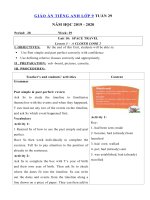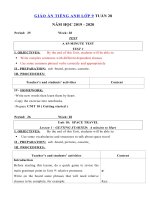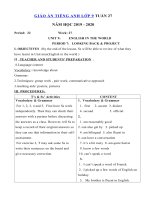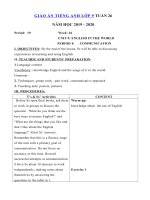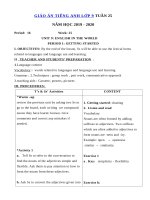Tải Giáo án tiếng Anh lớp 9 Tuần 15 sách mới - Giáo án điện tử môn tiếng Anh 9 theo tuần
Bạn đang xem bản rút gọn của tài liệu. Xem và tải ngay bản đầy đủ của tài liệu tại đây (118.21 KB, 7 trang )
<span class='text_page_counter'>(1)</span><div class='page_container' data-page=1>
<b>GIÁO ÁN TIẾNG ANH LỚP 9 </b>
<b> TUẦN 15</b>
<b>NĂM HỌC 2019 - 2020</b>
<b>Period: 43 </b> <b>Week: 15</b>
TEST
<b>Period: 44 </b> <b>Week: 15</b>
<b>Unit 6: VIET NAM:THEN AND NOW</b>
<i><b>Lesson 1 - GETTING STARTED: Our School in the past</b></i>
<b>I. OBJECTIVES: By the end of this Unit, students will be able to:</b>
Use the lexical items related to changes in transport systems, family groups,
and school life in Viet Nam in the past and at present.
<b>II . PREPARATION: sub -board, pictures, cassette </b>
<b>III. PROCEDURES: </b>
<b>Teacher’s and students’ activities</b> <b>Content</b>
<b>Activity 1: </b>
<i>Write the words Past and Present on the board and ask Ss </i>
to give another expression for the phrase.
<i>When they have given the phrase Then and Now, ask them </i>
to look at the picture and the heading
Our school in the past and ask them some questions:
<i>• Who can you see in the picture?</i>
<i>• Where do you think they are?</i>
<i>• Is there anything in the small pictures on the wall related </i>
<i>to past and present?</i>
Ss give their answers as a class. T can write their ideas on
the board.
Play the recording and have Ss follow along. After that, Ss
can compare their answers with the information in the
dialogue
a. Ss work in pairs to label the pictures with the words
-Students
-In the library
</div>
<span class='text_page_counter'>(2)</span><div class='page_container' data-page=2>
given. Allow pairs to share their answers before
asking them to discuss as a class. Then ask some Ss
to read the words/phrases aloud and correct their
pronunciation if necessary.
b. Have Ss work independently. Ss find the words with
the given meaning in the conversation. Then have Ss
share their answers with a partner before asking them
to discuss as a class.
c. Ss read the dialogue again to do this exercise. Ss
exchange their answers with a classmate. Ask for Ss’
answers as well as the explanation for their choices.
Write the correct answers on the board.
d. Ask Ss to do the exercise without reading the
conversation again. Ss compare their answers with a
classmate. Now ask them to check their answers by
reading the dialogue again. Call on some Ss to give
the answers.
1. Trench
2. tiled roof
3. facilities
4. photo exhibition
5. rubber sandals
6. thatched house
<i>Key:</i>
1. anniversary
2. fascinating
3. missing
4. conditions
5. improved
6. Proper
<i>Key:</i>
1. F (It was founded in the
1960s.) 2. T
3. F (They wore rubber
sandals and straw hats.)
4. NG
5. T
<i>Key:</i>
1. The conversation takes
place on the school’s 60th
anniversary.
2. Because it explains a lot
about how the school was in
the past.
3. There were trenches
outside the classrooms.
</div>
<span class='text_page_counter'>(3)</span><div class='page_container' data-page=3>
<b>Activity 2: </b>
Have Ss read the Remember! box individually. Then go
through the points as a class and see if any Ss can make
sentences using these adjectives and adverbs. Afterwards,
ask Ss to work individually on the gap-fill exercise. Check
the answers as a class.
<b>Activity 3: </b>
Now ask Ss to think about their own school’s history. First,
have pairs write a couple of questions about the school in
the past that they would like to ask T. Then, as a whole
class T can answer questions from Ss about the school when
she/ he started teaching. The aim is to generate a short
discussion. Now have Ss work in small groups to talk about
the changes to the school. Ask them to use the adjectives
and adverbs in Remember! box. T can tell Ss that they can
talk about:
+ the school principal and school teachers
+ the school playground
+ the library
+ the computer room
+ the classroom
made of wood and
some of them were missing.
5. They can learn that they are
lucky to have such great
learning facilities nowadays.
<i>Key:</i>
1. slight
2. dramatically
3. significantly
4. considerable
5. gradual
<b>IV- HOMEWORK:</b>
-Practice reading the dialogue.
</div>
<span class='text_page_counter'>(4)</span><div class='page_container' data-page=4>
-Prepare <b>A CLOSER LOOK 1</b>
<b>Period: 45 Week: 15</b>
<b>Unit 6: VIET NAM:THEN AND NOW</b>
<i><b>Lesson 2 – A CLOSER LOOK 1</b></i>
<b>I. OBJECTIVES: By the end of this Unit, students will be able to:</b>
Use the lexical items related to traditional crafts and places of interest in an
area
Say sentences with correct stress on the content words
<b>II . PREPARATION: sub -board, pictures, cassette </b>
<b>III. PROCEDURES: </b>
<b>Teacher’s and students’ activities</b> <b>Content</b>
<b>Activity 1: </b>
Now have Ss turn to the book and work in pairs to
label the pictures. Then ask them to brief y describe
those pictures. Check the answers as a class. Then
ask Ss:
<i>- Have you ever tried one of these means of </i>
<i>transport or road systems?</i>
<i>- How do you feel about using each of these means </i>
<i>of transport or road systems?</i>
<b>Activity 2:</b>
Have Ss work individually to f ll in the blanks.
Allow them to share answers with a partner before
checking
as a class.
<b>Activity 3:</b>
Give Ss a couple of minutes to work in pairs to do
the matching. Then check the answers as a class.
<i>Key:</i>
1. tram
2. flyover
3. elevated walkway
4. skytrain
5. underpass
6. tunnel
<i>Key:</i>
1. tunnel
2. elevated walkways
3. flyover
4. skytrain
5. underpass
6. tram
</div>
<span class='text_page_counter'>(5)</span><div class='page_container' data-page=5>
Ask the class these questions and ask for a show of
hands:
<i>- Who lives in an extended family?</i>
<i>- Who lives in a nuclear family?</i>
Now ask individual Ss
<i>- Can any of these adjectives be used to describe </i>
<i>your father/mother/sister/brother?</i>
Ask more able Ss to give a quick example to
<i>illustrate their answers, e.g. My father is tolerant. </i>
<i>He always lets us watch what we like on TV.</i>
<b>Activity 4:</b>
Have Ss work individually to complete the
sentences. Have them compare their answers in
pairs.
Afterwards, check Ss’ answers as a class.
<b>Pronunciation</b>
<b>Stress on all the words in sentences</b>
Have Ss silently read the information and the
examples in the box. Ask some Ss to summarise the
rules and read out the examples in the box or to give
their own examples.
2. b
3. e
4. d
5. c
6. A
<i>Key:</i>
1. extended family
2. sympathetic
3. obedient
4. tolerant
5. nuclear family
6. cooperative
Typically, a sentence has one word
or syllable that is stressed more
strongly than the rest of the stressed
syllables on the content words.
However, in some sentences used to
show urgency or surprise, all the
words are important. Therefore, we
put stress on one syllable of each
word. Sentences with the words
stressed may have the patterns
below:
</div>
<span class='text_page_counter'>(6)</span><div class='page_container' data-page=6>
<b>Activity 5:</b>
Ss write the sentences next to the patterns
individually, then compare their answers in pairs.
Ask some Ss to give the answers and quickly write
them on the board. Play the recording for Ss to
check their answers. Have the whole class repeat
<b>chorally after the recording or after T.rt the less </b>
<b>Activity 6:</b>
on This section can be done with some drama, so
encourage Ss to exaggerate a little and have fun.
They can also add hand gestures and facial
expressions to increase the dramatic element. Have
Ss work in pairs to describe the pictures quickly and
to f ll the bubbles with the utterances as in the
example. Then ask some pairs to read out their
utterances with the correct stress. Confirm the
correct answers. Lastly, have the class read all the
sentences chorally.
- If time allows, have Ss work in groups and think of
some other surprising or urgent situations.
They then decide what to say in those situations.
Have them demonstrate the situations and
utterances with the whole class.
- Play a quick game. Ask them to write as many
adjectives and adverbs describing degree and speed
of change that they have pair with the most words
<i>Key:</i>
1. OO – I know!, That long?, Don’t
cry!
2. OoO – Go away!
3. OOo – Keep going!
4. OOO – Don’t turn left!
<i>Suggested answers:</i>
1. Be quiet! OOo Don’t talk! OO
2. Don’t turn right! OOO
3. Wake up! OO Get up! OO
4. Smile please! OO Say cheese! OO
5. Don’t worry! OOo Don’t cry! OO
6. Look out! OO Look ahead! OoO
<b>IV- HOMEWORK:</b>
-Write new words then learn them by heart.
-Copy the exercise into notebooks.
-Prepare <b>A CLOSER LOOK 2</b>
Mời bạn đọc tham khảo thêm tài liệu Tiếng Anh lớp 9 tại đây:
Bài tập Tiếng Anh lớp 9 theo từng Unit:
</div>
<span class='text_page_counter'>(7)</span><div class='page_container' data-page=7></div>
<!--links-->





